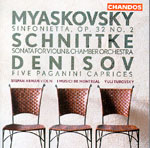Nikolai Myaskovsky’s Sinfonietta, composed in 1929, is not only the longest work (at 24 minutes) on this disc, but also is the least compelling. The first movement is built around the tireless reiteration of motif that Shostakovich would have played once and then been done with. However, in the second movement Myaskovsky does come up with some clever variations for his strangely Elgarian-sounding theme. Alfred Schnittke’s Sonata for Violin and Chamber Orchestra is the real catch of this collection. Composed for violin and piano in 1963, and re-scored for orchestra in 1969, the piece is alive with Schnittke’s trademark devices: brilliantly virtuosic solo writing, polytonality, abrupt transitions, chilling string harmonies and textures, and painfully poignant cantabile passages–in this case the brief, yet moving Largo. The finale features a cartoonish allegretto in which the violin, and later the strings, plays a wackily jazzy tune over bouncing harpsichord and orchestral accompaniment. Big fun!
In his Five Paganini Caprices (1985), Edison Denisov employs 18th-century concertante forms distorted by 20th-century harmonies and expressive devices in a manner similar to Schnittke, though without the latter’s crashing chords and explosive outbursts. For the most part, Denisov stays with the aesthetic framework of Paganini’s originals, but he really lets loose for the Caprice No. 24, turning out some of the most original variations on this tune since Brahms in the 19th century and Rachmaninov in the 20th. Stepan Arman devours these with his ravenous violin technique, one that serves him to dazzling effect in the difficult-sounding Schnittke work. Yuli Turovsky is right there with him, leading I Musici de Montréal in bracing performances of the accompaniments. Chandos presents it all in big, bold, vibrant sound.
































